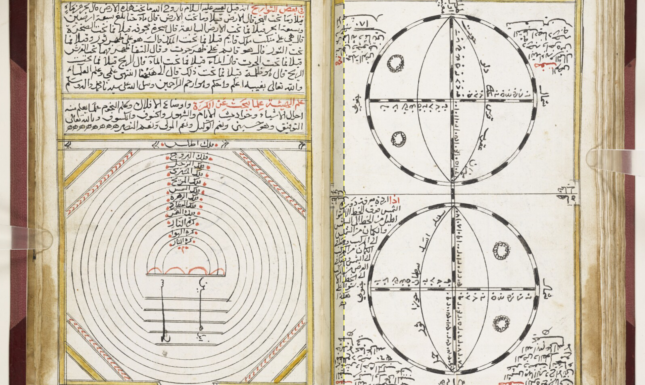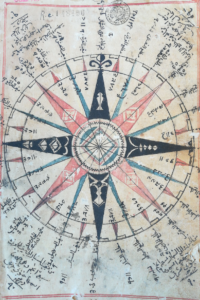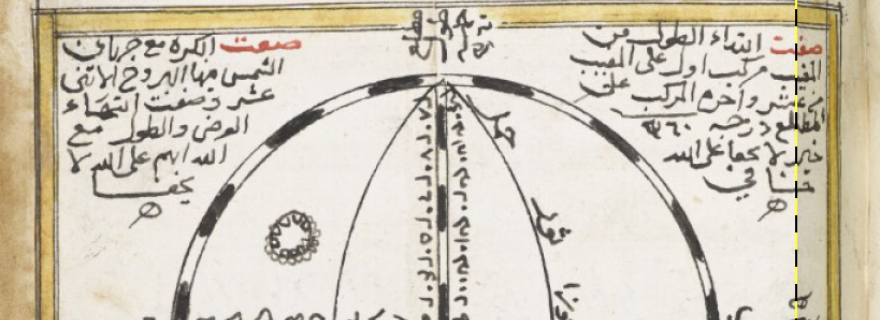Islamic Navigation: A “Middle Nation” at Sea
A newly discovered family of nineteenth-century Arabic nautical manuscripts is coming under study, presenting a mature tradition of a thousand years, an amalgam of techniques, history and Muslim life from all over the shores of the Indian Ocean.
Celestial navigation—determining positions at sea through observations of celestial bodies—, in any of its historical forms, may be said to have religious aspects, insofar as it re-ligates heaven and earth. And yet, apart from this general character, there does not seem to be anything essentially Islamic about the medieval and early modern nautical exploits of Muslims. The famous Arab pilots of the fifteenth and sixteenth centuries, notably Aḥmad ibn Mājid and Sulaymān al-Mahrī, were heirs to a very long tradition of Indian Ocean navigation based on factual and eminently applied knowledge, “neither from the East nor from the West”. They were transmitters of a body of knowledge and wayfinding techniques going back to ancient times, with geographical links as far as the Pacific, a craft rich in loan words from all over the shores of the Indian Ocean, from Persia to Indonesia and East Africa. Religious in character perhaps, but formally and practically universal, like using a sounding line, dropping anchor, or following a star.
Like other manifestations of Islamic science and Islamic culture in general, the technoscience of Arab pilots acquired through the centuries a distinct “perfume”, the unmistakable imprint of the Qur’anic revelation. Not all at once, however. Fifteenth-century navigation manuals explain that the first shipbuilder was Noah, that the art of sailing was fundamental for the determination of the qibla, that “you should not neglect your Ḥizb al-Baḥr” (“The Litany of the Sea”, a famous Sufi prayer), and so on. But what was at this stage an initial assimilation became a full-fledged integration in later centuries, as shown by recently discovered sailing manuals of the nineteenth century.
Nineteenth-century manuscripts of pilot handbooks (rahmānijāt, or simply dafātir) in London, Lisbon, Cairo, and Oman, and to a certain extent pilots’ notebooks in Oman, Kuwait, and elsewhere in the Gulf, are living witnesses to the uninterrupted transmission of nautical knowledge from the sixteenth century to our days. These documents, some of which bear traces of usage at sea and include details of specific trips, constitute as it were a second flourishing of Arabic nautical literature. After a documentary gap of approximately two hundred years, we encounter in them the main topics of and even extensive quotations from Ibn Mājid and al-Mahrī, evincing a clear continuity. We also find in them modern European technical developments, like tables of solar declination or traverse tables for basic trigonometric calculations. And all this traditional and yet technically up-to-date content is enveloped in and accompanied by the elements which make of it a truly Islamic synthesis.




The basics of cosmography are couched in Qur’anic formulas beyond mere pious rhetorical conventions, and may include unexpected digressions like a cosmological dialogue with the prophet ‘Īsā (Jesus). New sections, not found in the earlier literature, are devoted to qibla calculations and directions, while others give moral instruction within the parameters of Islamic ethical literature, for example including thorough advice on finding a good wife. As witnesses to the incessant movement of pilgrims to and from Jeddah, and also to the well-known to-ing and fro-ing of Sufis over centuries, we find in this new literature guides and prescriptions for hajj and umrah, as well as devotional poems of variable extension. Even the windrose design has evolved, to include now at the centre a depiction of the Kaaba, which was not a feature of earlier nautical windroses.
In this second wind of Arabic nautical literature, which, based on the current evidence, extends from the early nineteenth to the early twentieth century, we find a fascinating and mature blend of temporal and geographically diverse elements, and of technical and religious concerns. This synthetic achievement, reflecting as it does the actual role played by the Muslim navigators as agents of connectivity through the centuries, may perhaps justify considering this nautical literature as one of the most spectacular historical iterations of the Qur’anic phrase, addressed by God to the Muslim community, “We have made you a middle nation” (ja‘alnākum ummatan wasaṭan).
Further reading
- The Nautical Almanac, Qatar Digital Library. Available here
- Juan Acevedo, "A New Arabic Nautical Manuscript in Lisbon", Comparative Oriental Manuscript Studies Bulletin 7, 2021. Available here
Juan Acevedo is a graduate in Classics from the Universidad de Los Andes (Mérida, Venezuela) with a PhD in History of Philosophy from the Warburg Institute (London). After years working in Comparative Religion, he is currently with the ERC RUTTER Project in Lisbon (Centro Interuniversitário de História das Ciências e da Tecnologia), studying early modern Arabic manuscripts on Indian Ocean navigation.



0 Comments